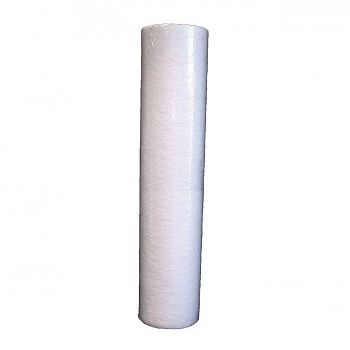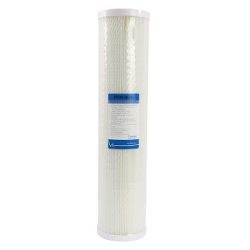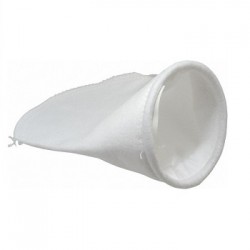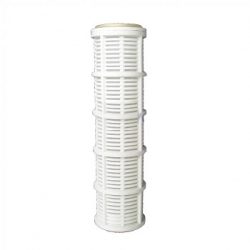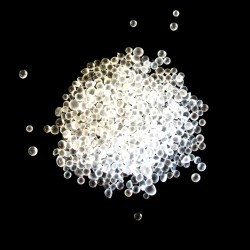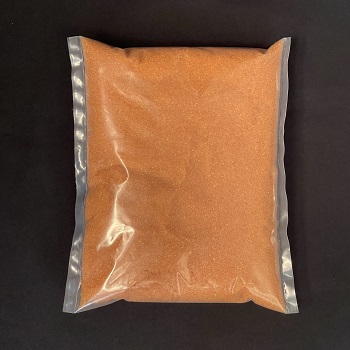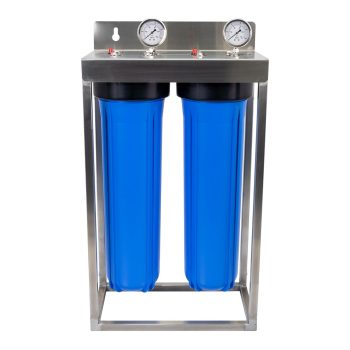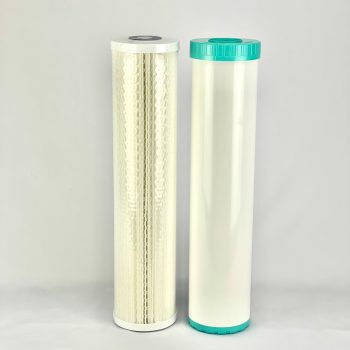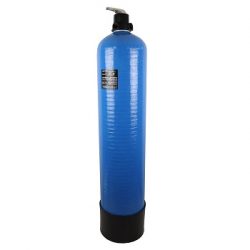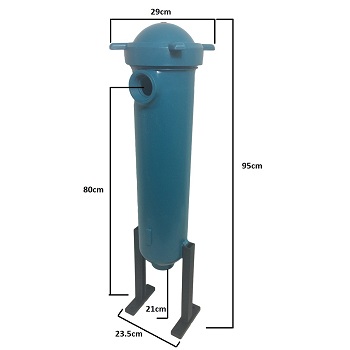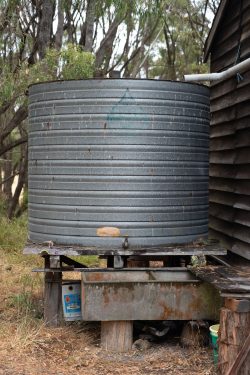
The Ultimate Guide to Whole House Water Filter Systems
September 9, 2022 3:52 pm Leave your thoughts
Whole house water filtration systems are a wonderful option for anyone interested in filtering all of the water entering their home or place of business.
Whole house systems can remove a wide range of contaminants at high flow rates, including sediment, chlorine, disinfection by-products and volatile organic compounds.
They are an affordable and reliable way to supply safe, clean, delicious water to all of the water outlets and water consuming appliances in your property.
In this guide, we are going to delve into the world of whole house water filtration, to help you learn more and make an informed purchasing decision.
If you are already aware of the benefits of whole house filtration and how they work, jump straight to the section on: how to choose a whole house water filter or our whole house filter system comparison charts.
If you have any questions at all, contact us on 02 6646 8565 or via email at sales@clarencewaterfilters.com.au.
Contents
What Kinds Of Contaminants Can Be Found In Australian Water?
What Are Whole House Water Filter Systems?
How Do Whole House Water Filters Work?
– Mechanical Filtration
– Adsorption Filtration
– Sequestration Filtration
– Oxidation/Reduction (Redox)
– Ion exchange
– Ultraviolet Sterilisation
Types Of Whole House Water Filter Systems
– Cartridge Whole House Filter Systems (Big Blue Style)
– Quick Change Whole of House Filtration Systems (3M™ Aqua-Pure Style)
– Filtration Systems With Integrated UV Steriliser
– Bag Filter Housings
Pros and Cons Of Whole House Water Filters
Choosing The Right Whole House Water Filtration System
Whole House Water Filter Systems Comparison Australia
Frequently Asked Questions
– How Much Does Complete Home Water Filtration Cost?
– What Is The Best Whole House Water Filter Systems in Australia?
– Who Can Install a Whole House Water Filter?
– How Much Does It Cost To Install A Whole House Water Filter?
– How Hard Is Whole House Water Filter Replacement?
– Do I Need A Whole House System That Reduces Scale?
– How Long Does A Whole House Water Filter Last?
– Do I Need A Whole House Sediment Filter?
– Do whole-house water filters remove lead?
– What Are The Disadvantages Of Water Purification?
– Is It Worth Getting a Whole House Water Filtration System?
– Wrapping Up
What Kinds Of Contaminants Can Be Found In Australian Water?
Although we have reasonably high-quality water in Australia, it can still contain a wide range of manmade and naturally-introduced contaminants.
Some of these contaminants can impact the flavour or odour of your water, like chlorine and hydrogen sulphide. They can make the water less palatable and impact the smell of your clothes.
Others contaminants can pose a potential threat to your health, including heavy metals, sulfates, and trihalomethanes (toxic disinfection by-products).
The reason why water can harbour so many contaminants is that it is a very effective solvent.
Water can absorb, transport, and breakdown a huge variety of compounds as it moves through dams, water tanks, treatment facilities, and water pipes to reach your home.
Some of the contaminants commonly found in Australian water include:
- Sediment
Particulate matter like sand, silt, algae, rust, dirt, mud, metal particles, and so on. - Chlorine and Chloramines
Chemicals added to water to kill any pathogens that may be present. Unfortunately, they also change the flavour/odour of water and may introduce other chemical compounds. - Disinfection By-products
When water is disinfected, the chlorine and chloramines can interact with decaying organic matter and other chemicals to form new compounds. Unfortunately, some of these compounds may be dangerous to human health. One of the most concerning disinfection by-products are Trihalomethanes, which have been linked to cancer and reproductive issues. - Heavy metals
Water can dissolve and transport toxic metals including arsenic, copper, nickel, lead, cadmium, chromium, and mercury. In high levels, these metals can have a severe impact on human health. - Volatile Organic Compounds (VOCs)
VOCs are chemicals commonly found in our daily environment. They can sometimes make their way into water and can have a detrimental impact on your health. - Chemical Insecticides, Herbicides and Fertilisers
These chemicals can be quite persistent in water and may make their way into your home. - Hardness
Hard water contains a high level of dissolved minerals. It can form scale when heated and may cause damage to appliances including coffee machines, water heaters, and steam ovens. Mostly a problem in SA, QLD, and WA. - Parasitic Cysts
Parasitic cysts including cryptosporidium, cyclospora, and giardia can sometimes be found in unchlorinated water from tanks, streams, dams or rivers. - Bacteria, Viruses and Protozoa
Untreated water can also contain other pathogens including bacteria, viruses, and protozoa. These microscopic contaminants are slightly more difficult to deal with and often require UV sterilisation of the incoming water.
Whole house water filter can reduce or eliminate most of these common contaminants.

What Are Whole Of House Water Filter Systems?
Whole of house water filtration systems treat water at the point of entry (POE) into a property, where the main water line comes into your property.
When placed in this position, the system will filter all of the water entering the property – providing you with clean water for drinking, showering, and laundry.
Whole home filter systems can also remove sediment particles and reduce scale build-up, which makes them useful for protecting appliances from damage.
Most whole house water filter systems use large sized filters, so they can successfully block, trap, sequester, or transform contaminants at the high flow rates.
How Do Whole House Water Filters Work?
The next section is a little technical. If you don’t need to know all of the technicalities of how whole house water filter systems work, jump to:
- Whole house water filter system pros/cons
- Choosing the right whole house water filter system
- Whole house water filter system comparison
You can also contact us on 02 6646 8565 or via sales@clarencewaterfilters.com.au for free advice on choosing a system.
Whole house water filtration systems can use several different approaches when it comes to removing contaminants, this can include:
- Mechanical Filtration
- Adsorption Filtration
- Sequestration Filtration
- Oxidation/Reduction (Redox)
- Ion exchange
- Ultraviolet Sterilisation
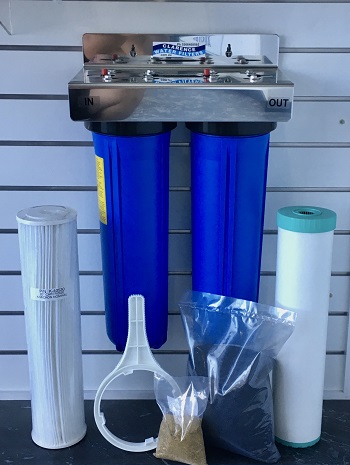
Mechanical Filtration
Mechanical filtration is the simplest form of filtration available. As the water passes through the filter, particulate matter becomes trapped or absorbed by the filter material.
You can think of a mechanical filter like a paper coffee filter, allowing water through while trapping coffee grounds, or in this case, solid contaminants.
This type of filtration can be used to remove sand, silt, rust, dirt, rocks, and other particulate contaminants.
Sediment filters will come with a micron rating. This refers to the smallest particulates that can be removed by the filter, in microns (one millionth of a metre).
The lower the micron rating, the finer the particulates removed from the water. So, a 1 micron filter will reduce smaller particles than a 5 micron and so on.
On Micron Ratings: In most cases, the micron rating mentioned will be a ‘nominal’ rating. This means it will reduce ‘most’ contaminants at the specified size. Usually anywhere from 60 to 90%. An Absolute rated filter has been laboratory tested to reduce at least 99.9% of contaminants at the specified size.
Mechanical filtration is often used in Stage 1 of a whole house water filter, to remove particulate contaminants before going onto to chemical removal filters or filters with finer micron ratings.
There are a several types of water filters which use mechanical filtration, including:
Poly-Spun Polypropylene Filters
Example: 20” x 4.5” 5 Micron Polyspun (2045PS5)
Poly Spun sediment filters are solid filters made from woven food-grade polypropylene.
They are typically cylindrical in shape with a hollow core. Water flows from the exterior of the filter, through the polypropylene walls and into inner core, before flowing out of the filter housing.
As water flows through the filter walls, particulates including sand, silt, rust, dirt become trapped.
There are also ‘graded depth’ poly-spun filters available, which are woven to have a finer micron rating deeper into the filter.
This allows the exterior of the filter to catch coarser particles with the interior layers catch finer ones. This approach gives the filter more capacity than a standard poly-spun.
Poly-spun filters are a very cost-effective option for sediment removal which makes them a popular choice.
Benefits of using Poly-Spun filters in your Whole Of House Filtration System:
- Affordable
- Low maintenance
- No cleaning involved
- Simple to install
Pleated Washable Filters
Example: 20” x 4.5” 5 Micron Nominal Pleated Washable Filter (2045PW5Nom)
Pleated washable filters have thin polypropylene pleats which can trap very fine particulate matter while letting water through.
They are usually designed in a similar way to poly-propylene filters, with a cylindrical shape and hollow core which allows water to exit the filter housing.
The filter’s pleats have a much larger surface area than a standard poly-spun filter. This means they can catch a lot more debris before becoming clogged.
Most pleated washable filters can be rinsed off several times to extend their lifespan. This makes pleated washables a popular choice for individuals with high sediment water, particularly those on tank or dam water.
Although pleated washable filters are a great choice, care should be taken to not overuse them. If they are kept too long, they may develop tears which allow contaminant bypass to occur.
Benefits of using Pleated Washable filters in your Whole Of House Filtration System:
- Excellent value for money (if well maintained)
- Longer lifespan than poly-spun filters
- Useful high-sediment situations like tank/dam water
Bag Filters
Example: Pentair 5 micron Bag Filter
The most common bag filter design is a circular ring attached to a bag, usually made from a nylon mesh or polypropylene felt.
The bag is usually placed inside a specialised bag filter housing. Water will flow into the top of the housing, then through the bag into an outlet on the bottom.
However, filter bags can also be used without a housing, by simply attaching them to a tap, vessel, downpipe, drain, water hose and so on.
Bag filters are very useful for capturing large particulates at very high flow rates. They come in a variety of sizes, to suit different housing types.
They work extremely well as a first stage of defence on dirty river, dam, or tank water – removing the coarser particles before the water flows into other filters for further treatment.
Benefits of using a Bag Filter in your Whole Of House Filter System:
- Great for tackling sediment-heavy water
- Excellent first line of defence on dirty tank, dam, or river water
- Nylon mesh bags can be cleaned many times
- Bags are very affordable
- Can handle very high-flow rates (higher than poly-spuns or pleated washables)
Screen filters
Example: 1025screen60 Washable 60 Micron Screen Filter
Screen filters use a fine plastic or metal mesh to capture large sediment particles. They can be cleaned and re-used dozens of times, which makes them a great choice as a first barrier of defence on heavy-sediment water.
Most screen filters are cylindrical in shape, with a hollow core. However, other designs are available.
Benefits of using a Screen Filter in your Whole Of House Filter System:
- Available in standard sizes, so work in normal filter housings
- Re-usable so offer great value for money
Sediment Wraps and Sediment Pads
Carbon block filters often have a thin sediment wrap around the exterior of the filter. Water must push through this wrap before it reaches the carbon. This removes most particulates before they have a chance to block the carbon.
Refillable carbon filters will often use sediment pads. The pads will trap some of the incoming sediment as well as locking the carbon into the housing.
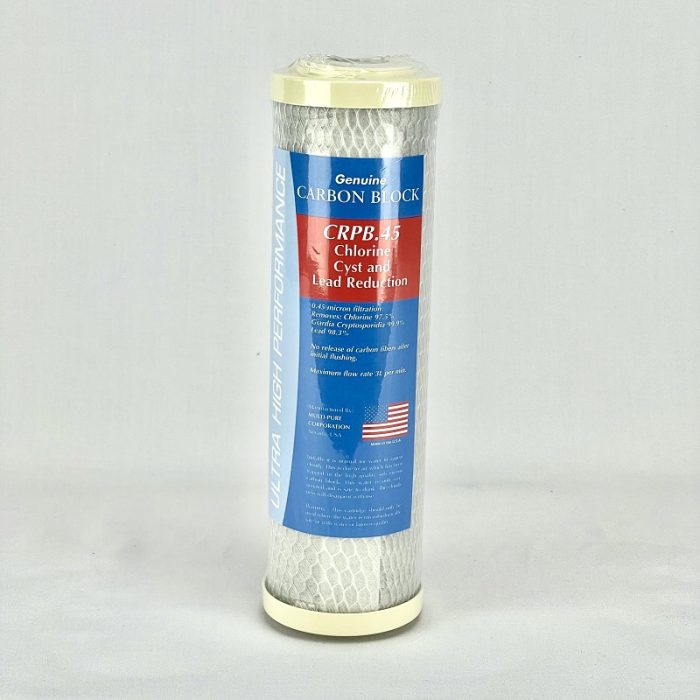
Adsorption Filtration
Adsorption refers to the capability of a material to attract and hold onto molecules.
When water flows through a material with a high adsorption capacity, some of the contaminants in the water can become stuck to its surface and removed from the water.
The most common form water filtration media to use this approach is activated carbon. It is carbon that has been modified through heat or chemical treatment to have additional pores on its surface.
When water flows through the carbon, the contaminants are adsorbed by the pores. Complex chemical contaminants can also be ‘catalysed’ or broken apart as they bump against pores.
The most common form of carbon used in these types of filters is crushed coconut shells. However, coal carbon and wood carbon are also popular options.
Carbon is very effective at removing chemicals from water. This includes chlorine, chloramines, volatile organic compounds, petrochemicals, pharmaceuticals, and so on.
It will also reduce bad tastes/odours from water, making it much more enjoyable to consume. Coconut carbon is particularly good in this respect as it ‘sweetens’ the water.
Carbon is often used as Stage 2/Stage 3 of a whole of house filtration system, reducing chemicals after the initial sediment filtration has occurred.
There two forms of carbon commonly used in whole house systems are:
- Granular Activated Carbon
This is a loose form of carbon granules. Often used in refillable whole house carbon filters. Ideal for chemical removal and taste/odour improvements at fast flow rates. - Carbon Block
Carbon blocks are chunks of compressed carbon combined with a binding adhesive. They are so compressed that they have a micron rating and will block sediment particles. Because they are denser than granular activated carbon, they can be better at catalysing complex chemical molecules and typically have more capacity.
There are also speciality carbons available, including:
- Silver impregnated carbon
Activated carbon which has been impregnated with silver to make it bacteriostatic (capable of killing of incapacitating bacteria). This form of carbon is commonly used in systems processing untreated water, to reduce the risk of bacteria growing in the cannister itself. - Catalytic carbon
Catalytic carbon has received additional processing to further increase the number of pores on its surface. This improves its chemical adsorption capacity and ability to break apart (catalyse) complex chemicals. Catalytic carbon is particularly useful for removing chloramines from water, as they have a complex structure.
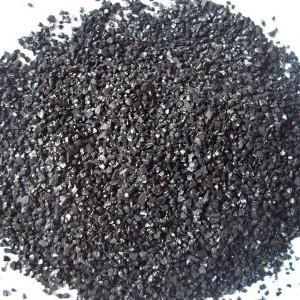
Sequestration Filtration
Sequestration is the action of chemically isolating a substance.
The most common media used for sequestration in whole house water filter systems is polyphosphate.
It is used to sequester or ‘wrap up’ calcium and magnesium ions in the water, preventing them from forming scale on hard surfaces.
The polyphosphate dissolves in the water over time and is topped up as needed. A great solution for properties in hard water areas like WA, SA, NT, and QLD.
Usually placed last in stage, in a refillable filter that also contains carbon. It is normally placed at the top of the filter, so the user can unscrew the filter and top up the polyphosphate as needed.
Oxidation/Reduction (Redox)
Redox reactions refer to electrochemical reactions which cause molecules to lose or gain electrons.
In terms of water filtration, the most common redox media in use today is KDF, which is a proprietary blend of copper and zinc.
As oxygenated water flows through KDF, redox occurs with several contaminants either gain or losing electrons. Some of the reactions that occur include:
- Chlorine loses electrons to become chloride, a harmless electrolyte. This action removes must of the bad flavour/taste associated with chlorine.
- Some chloramine molecules are broken apart into their constituent parts
- Calcium ions change form, precipitating out of the water and forming aragonite (reducing scale build-up)
- Dissolved lead is precipitated out of the water and electroplated onto the copper particles.
KDF is often used in conjunction with carbon in whole house filter systems to provide improved chemical protection.
It is mostly used in refillable filter cartridges with KDF on the bottom (so it contacts the water first) then carbon.
The KDF reduces the amount of chlorine/chloramines in the water. The water then pushes into the carbon, removing even more chlorine/chloramines along with other chemicals.
When used in conjunction with carbon it can dramatically improve chemical removal rates and extend the lifespan/capacity of the carbon.
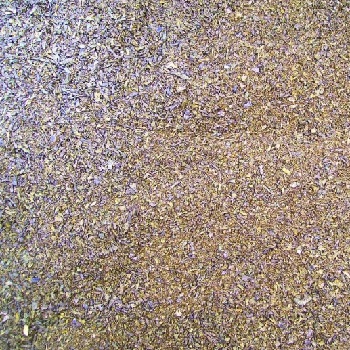
Ion Exchange
Ions are negatively or positively charged atoms or molecules.
An ion exchange resin will take some of the ions out of the water that is flowing past and replace them with an inert molecule, like hydrogen or sodium.
The resin itself is made from small polymeric beads with tiny cracks that attract and trap passing ions, replacing them an alternative molecule.
Resins are fantastic at removing dissolved solids including carbonate, bicarbonates,
There are three general categories of resins:
- Anion resins
Anion exchange resins hold a positive charge, so they will attract and exchange negatively charged contaminants for harmless particles. - Cation resins
Cation resins are the opposite, they are negatively charged, so they will attract and exchange positively charged ions. Useful for removing the carbonate/bicarbonate hardness responsible for forming scale (also known as temporary hardness). - Mixed bed resins
A mixture of anion and cation resin. Useful for removing total hardness.
The main challenge with using resin in a whole house water filter system is that it requires a large amount of contact time to be effective – which means a relatively large vessel of resin.
For this reason, it’s more common for people to use polyphosphate for whole house scale reduction often with KDF as well.
Ultraviolet Sterilisation
Ultraviolet water sterilisers can be used on disinfect untreated water sources from tanks, bores, rivers, dams, or creeks.
They use powerful beams of ultraviolet light to kill or incapacitate potentially dangerous pathogens in water including bacteria, protozoa, algal spores and viruses.
For UV sterilisers to be effective, most of the particulate matter must be removed prior from the water prior to treatment. This prevents pathogens hiding behind particulate matter and avoiding exposure to ultraviolet light.
The golden rule is that the water must have sediment filtered down to a minimum of 5 microns. If your water is very dirty, it may require multiple sediment filters to get it to the stage where a UV steriliser can be effective.
UV sterilisation is usually unnecessary on water that has been treated with chlorine, as the chlorine will kill most of the pathogens that are present.
The size of the UV system used is based on the maximum water flow coming into your property, measured in either litres per minute (LPM) or gallons per minute (GPM).
UV disinfection is generally considered unnecessary for properties on town water, as proper disinfection of town water should kill any pathogens that are present.
Types Of Whole House Filter Systems
There are several types of whole house filtration systems, with different filtration approaches. In some installations, multiple types will be combined to achieve certain filtration goals. Here are the most common types of systems:
Cannister/Cartridge Whole House Filter Systems (Big Blue)
With this style of whole house filtration system, water filter cartridges are placed inside of a cannister which is screwed into a filter head.
Water flows into one side of the filter head, then runs through the cartridge before exiting out of the other side of the head.
These types of units often have several types of cartridges in a row to achieve different styles/levels of filtration.
A common configuration used for whole house filtration is a sediment reduction filter followed by a chemical reduction filter. This removes the vast majority of contaminants from your water while maintaining a reasonably fast flow rate.
The most popular cartridge-based system is the “Big Blue” system. It uses large 10” x 2.5”, 10” x 4.5”, or 20” x 4.5” cannisters which screw into a filter head.
Cartridge style systems gives you plenty of flexibility as you can change the types of filters placed inside of the cannisters. It is usually a cheaper way to go as generic 10” and 20” filters are quite affordable.
Another advantage of using a cannister/cartridge system is that you can use refillable filter cartridges.
Refillable cartridges can be filled with filtration media that targets the specific contaminants you are concerned about.
It’s also possible to have multiple types of filtration media in a single refillable cannister, with separator pads between each layer.
For example, you can combine:
- Carbon with KDF55 to obtain improved chemical protection
- Carbon with polyphosphate to obtain chemical protection plus scale reduction
This approach offers a great deal of flexibility and can lead to significant cost savings.
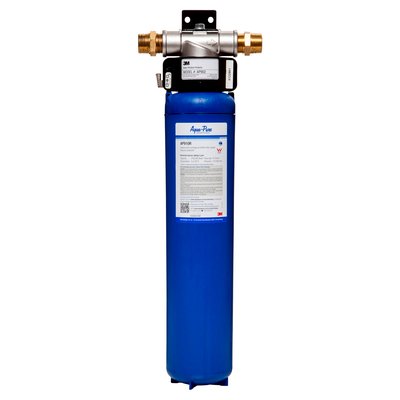
Quick Change Whole of House Filtration Systems (3M™ Aqua-Pure Style)
The other common type of cartridge-based system uses fully-enclosed filter cartridges which are screwed directly into a filter head. An example of this style is the 3M™ AP900 series, as shown above.
The main advantage if this style of system is that you never touch the filter surface directly, as it is fully enclosed in a plastic shell.
As a result, the water filter always remains sterile. That’s why 3M™ refer to this system as their “Sanitary” Quick Change System.
Once the system is installed, changing filters is like changing a (very large) light bulb.
All you need to do is rotate the filter to the left and pull it down to remove. The water flow to the housing will automatically be cut off.
Inserting a new filter is a matter of pushing it into the head, then turning it clockwise – it can’t get much simpler.
Because the o-rings are attached to the replacement filter, new o-rings will be installed every filter change. This is different to the Big Blue system, which has o-rings on the sumps, which need to be replaced every 2-3 years.
The simplicity of AP900 filter changes can lead to significant savings in the long run as there is no need to call a plumber.
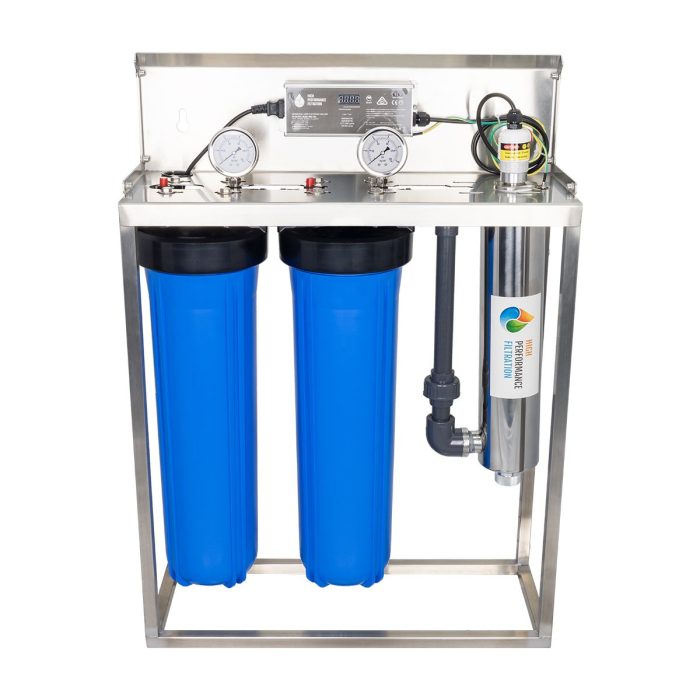
Filtration Systems With Integrated UV Steriliser
Some filtration units combine water filter housings with a UV steriliser in an integrated system.
The water is be filtered by the filter system before going through a UV unit, which kills or incapacitates any viruses, bacteria, algal spores, and protozoa.
This type of unit is designed for removing contaminants from untreated water sources like tank, dam, river, or bore water.
Media Vessels
Media vessels are large containers which can filled with different types of media. Water flows into the vessel then through the media before exiting.
They are often used for:
- Carbon filtration
When a very high flow rate is required (for large homes, offices and unit blocks) a large vessel of carbon may be required. - Calcite filtration
Large vessels of Calcite and/or Corosex can be used to increase the pH of acidic water. - Ion Exchange Resins
Because ion exchange resins require a great deal of contact time, larger vessels must be used to support high flow rates.
Average households on reasonable quality town/tank water usually won’t need a media vessel, as they can achieve most filtration goals with a cartridge filter system.
However, if very fast flow rates are required for a large building or there are unique issues with the water (like low pH), then a media vessel will be useful.
Bag Filter Housings
Specialised housings used for bag filters.
The bag is placed inside the housing, often wrapped around a basket to help it maintain its form. Water flows into the top of the housing before pushing through the bag and into the outlet.
The bag traps sediment particles as the water flows through, including sand, silt, rust, dirt and so on. The micron rating of the bag will determine the size of the smallest particles captured by the filter.
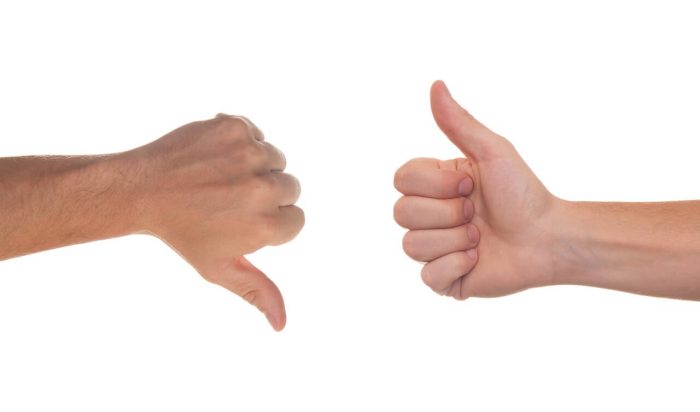
Pros and Cons Of Whole House Water Filters
All water filtration systems have a unique set of advantages and disadvantages. For whole house water filter systems, the pros and cons include:
Pros Of Whole House Water Filtration Systems
Convenient
Once your system is installed, you will enjoy clean and delicious tasting water from every water outlet in your home. You won’t need to worry about refilling jugs, switching on appliances, or monitoring your usage. There is much less maintenance compared to having several water filtration systems throughout your home.
Filters 100% of Your Water
All of the water entering the home is filtered by a whole house system. This means it will help you enjoy cleaner drinking water, more enjoyable showers, and cleaner laundry water – all from a single water filtration unit.
This is usually a better approach compared to having several units throughout your home, which usually leads to higher running costs and more maintenance.
Can Dramatically Reduce Chemical Content in Water
Filtration media like carbon and KDF can significantly reduce the chemical content of the water coming into your home or place of business. They will reduce chlorine, chloramines, volatile organic compounds, polychlorinated biphenyls, herbicides, pesticides, disinfection by-products and many other chemicals. You and your family will enjoy water that is safe to consume and free of potentially harmful contaminants.
Food Tastes Better
The quality of your water can have an huge impact the quality of your food. That’s because water is used throughout the cooking process.
Every time you wash your produce, dilute sauce, cook pasta or rice, or steam food, the quality of your water can have an impact. By removing chemicals and bad tastes/odours using a whole house filter, you can enjoy the real taste of your food, free of unnecessary impurities.
Protects Your Appliances and Plumbing From Damage
Sediment and scale build-up can cause a significant amount of damage to water consuming appliances. They can build up over time, blocking lines and caking heating elements of dishwashers, coffee machines, steam ovens, and water heaters.
By using filtration to reduce sediment and scale build-up, you can extend the lifespan of your appliances, along with their reliability. A simple way to save money.
Cleaner Clothes
Have you ever washed your clothes only to discover that they still have marks on them? Or worse still, have you discovered new stains on your clothes after they come out of the washing machine?
These types of issues are often caused by the presence of sediment or chemicals in water. Sediment can leave stains or discolouration while chemicals can interact with detergents in unexpected ways.
Using a whole house system reduces the level of sediment/chemicals, helping you enjoy clothes that are clean and fresh-smelling.
Improves Your Appearance
Chlorine is a harsh chemical which can really dry out your skin and hair. It strips natural oils and can cause pH imbalances in your skin. It can also worsen the symptoms of conditions like eczema, psoriasis, and rosacea.
Once your whole house filtration system has removed most of the chlorine from your water, you can avoid its drying effect. This can dramatically improve the appearance of your skin and hair.
Showering Is More Enjoyable
Showering in clean, chemical-free water is a completely different experience. The water feels softer and more refreshing. There are no noxious chemical smells from the chlorine and you won’t be breathing in chemical gases.
Better Water for Your Pets
In addition to protecting your health, purifying your water will also protect your pets. They will enjoy the health benefits of drinking cleaner water and bathing in water without harsh chemical compounds.
Maintenance Is Simple
Maintaining a whole house system is a breeze. If you have a Big Blue system with disposable filters or a 3M™ Aqua-Pure AP900 Series System, it’s just a matter of replacing the filters every 6 to 12 months.
If you have a Big Blue with reusable filters, you’ll just need to hose off the pleated washable every 3-4 months and refill the refillable filter every 6-12 months.
Looking after a single whole house filter system is much easier than trying to manage individual filter systems throughout your home.
Different Filtration Methods For Different Filtration Goals
You can easily combine various filtration systems, filter cartridges, and media types to achieve any goal. Whatever problem you are experiencing with your water, there is a solution available.
Cons Of Whole House Water Filtration Systems
Not Suitable For Renters Or Those In Apartment Blocks
Most whole house water filtration systems require a modification of the water mains line entering the property. This makes it unsuitable for renters, who may not have permission to make substantial alterations to the property they are living in.
Installation Usually Requires a Plumber
As mentioned a moment ago, installing a whole of house water filtration system is not a simple matter. You will need to cut into the water mains line, which is a task best performed by a qualified plumber or skilled handyman.
Placement Can Be Problematic
Whole of house water filter housings are generally rugged, weather-resistant pieces of equipment. However, exposure to ultraviolet light, heat, and harsh weather can negatively impact their lifespan.
This means you will need to install your system in a location out of the weather. Alternately, you could install a cover for your filter system to give it some protection.
The High Performance Filtration Whole House Units (HPF-2, HPF-3 and HPV-UV) come with corrosion-resistant stainless steel housings to protect the system. This provides an excellent level of protection and gives the system a very modern look.
Initial Installation Costs Can Be High
The initial purchase price of a whole house water filter can be anywhere from $300 to $1,000+. However, you might have to also pay for a plumber to install it. This can add anywhere between 10% to 25% to the cost of your new filter system. Large industrial systems can cost even more to install and maintain.
There Are Ongoing Costs
All water filtration systems will have some running and maintenance costs. Although the most basic sediment-only systems can cost as little as $50 per annum to maintain, more complex units can cost several hundred dollars per year.
In addition to purchasing replacement filters you may need bags of media, UV sleeves, UV lamps, and o-rings. If you want to learn more about the costs involved with running a whole house water filter system, give us a call/email today.
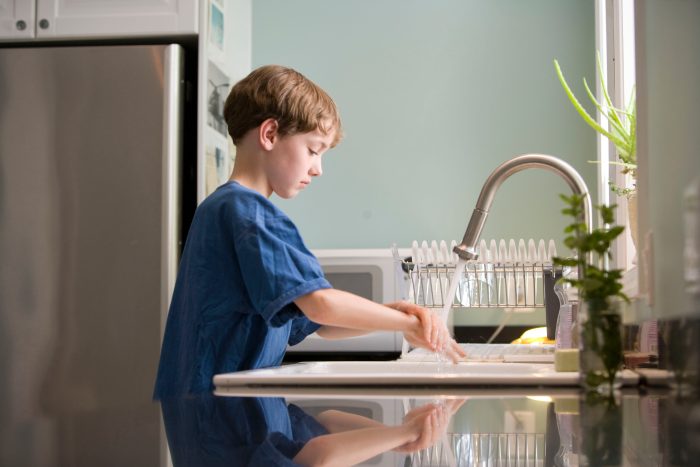
Choosing The Right Whole House Water Filtration System
What is the best water filter system for whole house?
The ideal system will be effective, reasonably priced, simple to maintain and deal with the specific contaminants that you are concerned about. It will also be within your budget.
Here are a few considerations to help you find the best whole house filter system for your home or place of business more quickly.
Are You Using Town, Tank or Bore Water?
Town Water
If you are using town water, it should be reasonably clean in terms of sediment. However, it may have high levels of chemicals and a bad taste or odour.
In most cases, a Twin Big Blue system with 5 micron Sediment filter and some type of Carbon filter (carbon block or granular carbon) is all that is required.
If chemical levels are very high in your area or there are chloramines present, it may be worth using a filter with Catalytic Carbon and possibly KDF. This will help you deal with more complex chemicals, which tend to be more resilient against carbon filtration.
If you live in WA, SA, NT, or QLD, it may have also high levels of dissolved solids including scale-forming carbonates/bicarbonates. In this situation, the addition of polyphosphate to your filtration system is a good idea.
Options for normal town water:
If you are on reasonably good town water, you will fantastic results with any of the following:
Twin Big Blue Filtration System For Town Water (Disposable filters)
Twin Big Blue Filtration System For Town Water (Refillable filters)
3M™ Aqua-Pure™ AP903 Whole of House Sediment and Chemical Reduction System
Complete Filtration Systems – HPF-2 Twin Filtration System
Options for high chlorine/chloramine town water:
If you have a high level of chemicals in your water supply, it may be worth using catalytic carbon or catalytic carbon + KDF. They will do a better job of reducing chemicals than activated carbon alone. The following options would be ideal:
Twin Big Blue Filtration System For Town Water – Chloramines (Reusable filters)
3M™ Aqua-Pure™ AP903 Whole of House Sediment and Chemical Reduction System
Complete Filtration Systems – HPF-2 Twin Filtration System
Complete Filtration Systems – HPF-3 Triple Filtration System
Options for town water in hard water areas:
If you are in an area with hard water, incorporating some polyphosphate into your filtration can help you reduce scale build-up throughout your home. Consider the following systems:
Twin Big Blue Filtration System For Town Water – Chloramines and Scale (Reusable filters)*
3M™ Aqua-Pure™ AP904 Whole of House Sediment, Chemical and Scale Reduction System
Complete Filtration Systems – HPF-3 Triple Filtration System (With Polyphosphate)
* There are also Triple Big Blue systems available for harsh water. Give us a call for to learn more.
Untreated Tank Water
Untreated tank water often contains higher levels of sediment than town water.
For this reason, sediment filters with a higher micron rating (10, 20 or 50 micron) are often recommended as they won’t clog up as quickly. However, they will still remove the bulk of the sediment from your water.
If you there are pathogens in the water like viruses, bacteria, protozoa, or parasitic cysts (cryptosporidium, giardia), a UV steriliser should also be used to ensure your water is safe to consume.
If UV is going to be used, sediment particles above 5 microns in size must be filtered out before sterilisation. If your water is sediment-heavy, it may take multiple sediment filters to get it down to this stage.
Alternately, using a very fine ceramic filter for drinking water can provide protection against bacteria, protozoa, and parasitic cysts.
It’s worth noting that carbon filtration isn’t always necessary for tank water. If your water tastes great and there is no risk of chemical contamination from agricultural overspray, you may not need a carbon filter.
Options for clean tank water (great taste/odour):
If your tank water smells/tastes great and there are no concerns surrounding bacteria, then a sediment-only system might be all you need. Consider the following:
Whole of House Sediment Water Filter Rural or Town – Single 20″ x 4.5”
3M™ Aqua-Pure™ AP902 Whole of House Sediment Reduction System (LOW SEDIMENT ONLY)
Options for clean tank water (some taste/odour issues):
Twin Big Blue Filtration System For Tank Water
Complete Filtration Systems – HPF-2 Twin Filtration System (Silver Carbon)
Complete Filtration Systems – HPF-3 Triple Filtration System (Silver Carbon)
Options for dirty tank water with possible pathogenic activity:
Complete Filtration Systems – HPF-UV Triple Filtration System with UV
Twin Big Blue Filtration System For Tank Water + SLT 40 UV System*
* The size of the UV system you choose will be based on the maximum flow rate of water entering your property. Fast flow rates require large systems to ensure pathogens receive a sufficient does of UV light. Contact us to learn more.
Dam, River, Creek Water
River from natural sources of water can contain even more sediment than town water, which may require multiple stages of sediment filtration Having a bag filter housing as a first stage can be very helpful when using this type of water.
Using dam, river or creek water also increases the risk of exposure to bacteria and viruses from animal carcasses and faeces. As a result, having a UV system installed is often a good idea also.
It’s always advisable to have this type of water tested, so you can identify any potentially dangerous contaminants which may be present.
If the water is of reasonable quality, it may be possible to treat it using one or more sediment filters, then UV disinfection, and a carbon filter. Some experimentation may be required to find the ideal combination of sediment filters.
Are There Any Unusual Issues Affecting Your Water?
You may also have unusual issues affecting your water, which require the use of additional filtration, like:
- Low pH water (acidic water)
If your water is acidic, it may begin to corrode the copper pipes in your home. This can cause pin hole leaks and may lead to copper toxicity. The solution to acidic water is usually a vessel containing Calcite (calcium carbonate) or Calcite and Corosex. It dissolves into the acidic water, buffering pH to a safer level. - Heavy metals
Heavy metals can enter the water supply from both natural and manmade sources. They can be difficult to remove using a whole house system, as the flow rates that are involved are too fast. Using KDF will reduce some heavy metals, but the best option is to use a carbon block filter for your drinking water, which is rated for heavy metal removal. - High Level Of Dissolved solids
High levels of dissolved solids may cause water to become corrosive. It also might have excessive levels of chloride, iron, copper, manganese, zinc, and other minerals. Dealing with high TDS can be challenging and may require resin filtration.
If you have an unusual issue with your water, it’s always advisable to have it tested so you can determine if filtration is viable.
How Big/Busy Is Your Property?
The maximum water flow rate used by your property will play a big role in determining the size/type of filter system you need.
Most standard households with 2 bathrooms, 1 kitchen, 1 laundry, and 4-6 occupants will rarely go beyond 20 litres per minute flow rate, so a standard Big Blue Twin System or 3M AP900 System is all that is needed.
However, if one of the following applies, then a standard installation may be insufficient:
- Busy households with many 8+ occupants often using water simultaneously
- Large properties with more than 3 bathrooms/2 laundries and 2 kitchens that are often in-use simultaneously
- Businesses that have high flow rate requirements
If that sounds like you, contact us for some free advice. In some cases, the incoming water line can be split between two standard whole of house systems, while in other situations a bag filter housing for sediment protection and a vessel for chemical protection is ideal.
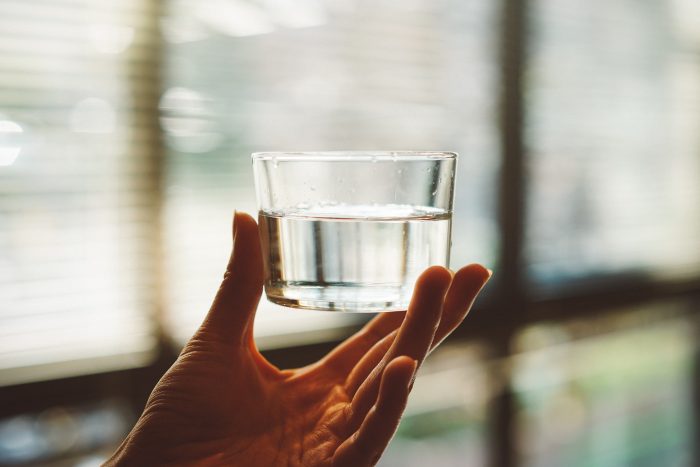
Whole House Water Filter Systems Comparison Australia
Here is a quick comparison between the most popular whole house water filtration systems in Australia, including the Big Blue Whole House Filter System, the 3M™ Aqua-Pure Whole House Water Filter System, and the High Performance Filtration Systems.
Click this link to view out Tank/Rural Whole House Water Filters Systems
Click this link to view our Town Water Whole House Water Filter Systems
Frequently Asked Questions
How Much Does Complete Home Water Filtration Cost?
A Single Big Blue Whole House Filtration System designed for sediment removal can be as low as $200 while twin systems for town water chlorine removal start around the $550 mark.
Of course, there will be some installation costs on top of that. But it’s really a small amount of money to pay for a system that will dramatically improve the quality of your water.
Running costs can be as low as $55.00 per year for sediment-only systems. Twin units with a refillable carbon cannister and pleated washable cost about $130.00 per year to run.
What Is The Best Whole House Water Filter Systems in Australia?
The best whole house water filtration system for your home will vary based on:
- The quality of the water where you live
- The type of water you are using (town, tank, bore, creek, river etc)
- The size of your home and the amount of water you use
- The specific contaminants you are concerned about
For most people on soft town water in property with 1 to 3 bathrooms, a Twin Big Blue system with a sediment filter and a carbon filter is all that is required.
We often recommend the system with reusable filters as it is cheaper to run than a disposable filter system.
The 3M™ AP903 can work really well, as long as the sediment levels in the water isn’t too high. Contact us if you are unsure on the suitability of this filter for your water.
If you have chemical sensitivity or are in an area where they use a lot of chemicals, a system with a Sediment Protection plus Catalytic Carbon would be better as it can catalyse complex chemical molecules.
Individuals in a hard water area, benefit from the addition of polyphosphate, to reduce scale. If that sounds like you, check out the big blue filter systems.
Who Can Install a Whole House Water Filter?
The installation process involves locating the water mains and cutting into it. Additional pipework is installed to divert the water through the filtration system. The filter housing will also need to be secured on a wall.
This difficulty of this process can vary based on the location of your water mains, any items in the way, the amount of space available and so on.
It’s important to remember that whole house filter systems are best off installed in a location that is protected from the sun and the weather. If no such location is available, you can build or purchase an enclosure to protect your whole house filter.
How Much Does It Cost To Install A Whole House Water Filter?
The cost of installation will vary based on:
- The type of water filter system being used and its attributes (size, connection requirements)
- The location of your incoming water line
- The presence of any impediments to installation like plants, hoses, groundcover, and soil.
- Whether you have extra features, like a new tap just after the system or a bypass system which allows you to bypass the filter system during filter changes
In most cases, the average plumber installing a system on the average home will spend somewhere between 1 to 2 hours to install it. However, complex installations may be 3 or more hours.
When installing the system, place it in a location that is out of the sun and weather if possible.
How Hard Is Whole House Water Filter Replacement?
Replacing filters is a very simple task that most people would feel comfortable doing. It usually takes less than 10 minutes.
For Big Blue Whole House Water Filter Systems, start by turning off the water supply. You will then open a tap or use the pressure release button to relieve any water pressure in the system.
You’ll then use a filter spanner on each sump, turning it from right to left to undo the sump. Next, you will remove the old filters, clean the sumps, and replace/refill the filters.
Before closing the system back up, we recommend adding some food grade silicon grease or some vegetable/olive oil to the sump o-rings. The sumps should be done up hand tight (no need for a spanner usually).
After that, you need to open up the first tap after the filter system before turning the water on. This will release any carbon fines in the system before they can make their way into your property’s tap. Turn the water on and let 10-20 litres of water drain before closing the tap and letting water into your property.
If you have a 3M™ Aqua-Pure AP900 Series Whole House Water Filter, then changing filters is even easier. All you need to do is grab the water filter, turn it to the left, then pull down.
The water will automatically turn off as the filter disengages. To install the water filter, insert it into the head and turn it to the right. You won’t need to change any o-rings as they are already installed on the replacement filter itself.
Do I Need A Whole House System That Reduces Scale?
If you are just moving into a new home or the home is new, you can check the local water reports. General Hardness (GH) above 8 dH or 140ppm, indicates that you have moderately hard water and would benefit from having some scale protection.
For whole house filtration systems, that means adding some polyphosphate into your refillable carbon filter or using a system that specialises in scale reduction, like the 3M.
How Long Does A Whole House Water Filter Last?
The lifespan of your water filters will vary based on several factors including:
- The types of filters you have installed
- The level of chemicals in your water
- The amount of sediment in the water
- How well you maintain your system
- The types of contaminants you encounter
- How much water you are consuming
- The flow rates you are using
However, in general terms you can expect:
- 20” x 4.5” Poly-spun filters will last 6 months
- 20” x 4.5” Pleated washables will last 6-18 months (if well maintained)
- 20” x 4.5” Refillable carbon filters will last 6 -9 months
- 20” x 4.5” Carbon block filters will last 6-9 months
Some forms of media, like calcite and polyphosphate, will dissolve at different rates, based on the quality of the water you are using.
High-quality water filter housings are very durable and built to survive the harsh Australian weather. However, their lifespan will be affected by how much UV and harsh weather the unit is exposed to.
We always recommend installing your whole of home water filter system in a location that is protected from the weather.
Do I Need A Whole House Sediment Filter?
If you live in an area with very clean low-sediment water, you may not need a sediment filter at all. Some parts of Sydney fall into this category as the water authorities serving metropolitan Sydney use settling ponds to process their water supply.
However, it’s worth noting that sediment levels can change, particularly when council is doing work to local water infrastructure. Even if the water is normally low-sediment, you may experience periods of high sediment if they are working on nearby ducts or pipework.
If you don’t have a sediment filter protecting your carbon filter, you may find that the carbon filter clogs up with sediment, impeding your flow rate. This might force you to replace your carbon filter prematurely.
Do whole-house water filters remove lead?
There are specialty whole-house carbon water filters which remove lead and other heavy metals including mercury, copper, manganese, chromium, and arsenic.
However, the whole house carbon filters that remove heavy metals are often very fine carbon blocks, which are tricky to use in high sediment situations.
As a result, it’s often recommended that people with heavy metal issues add a secondary filtration system for their drinking water. A lead removal under-sink system has much finer filtration (usually down to 0.5 micron) which means it has a slower flow rate than a whole house unit. Talk to us today if you believe you have heavy metals in your water.
What Are The Disadvantages Of Water Purification?
- It can be hard to find room to install the system
- There are running costs and maintenance costs involved
- Installation can be costly for some properties
- Not ideal for rentals and units
Is It Worth Getting a Whole House Water Filtration System?
The necessity of a whole house water filter depends on your location, the quality of your water, and how concerned you are about contaminants being in your water. Your budget may also play a role in determining whether you should get one.
However, in our experience, no one has ever installed one then complained about the effect it has had on their water.
Whole house filtration systems can make a dramatic difference to the quality of your water. From improving the taste/smell of your water to making your clothes cleaner and removing some potentially dangerous contaminants – it can really improve your lifestyle and general health.
Products Featured In This Guide
Twin Big Blue Filtration System For Town Water (Disposable filters)
Twin Big Blue Filtration System For Town Water – Chloramines (Reusable filters)
Twin Big Blue Filtration System For Tank Water
3M™ Aqua-Pure™ AP902 Whole of House Sediment Reduction System
3M™ Aqua-Pure™ AP903 Whole of House Sediment and Chemical Reduction System
3M™ Aqua-Pure™ AP904 Whole of House Sediment, Chemical and Scale Reduction System
Complete Filtration Systems – HPF-2 Twin Filtration System
Complete Filtration Systems – HPF-3 Triple Filtration System
Complete Filtration Systems – HPF-UV Triple Filtration System with UV
Wrapping Up
As you can see, there are plenty of reasons to install a whole house filter. They can help you ensure your water remains clean and safe to consume. If you have any questions at all, contact us today!
Clarence Water Filters Pty Ltd
Phone: 02 6646 8565
Email: sales@clarencewaterfilters.com.au
Categorised in: Buyer's Guides, Water Filtration, Whole House Water Filtration
This post was written by Greg

